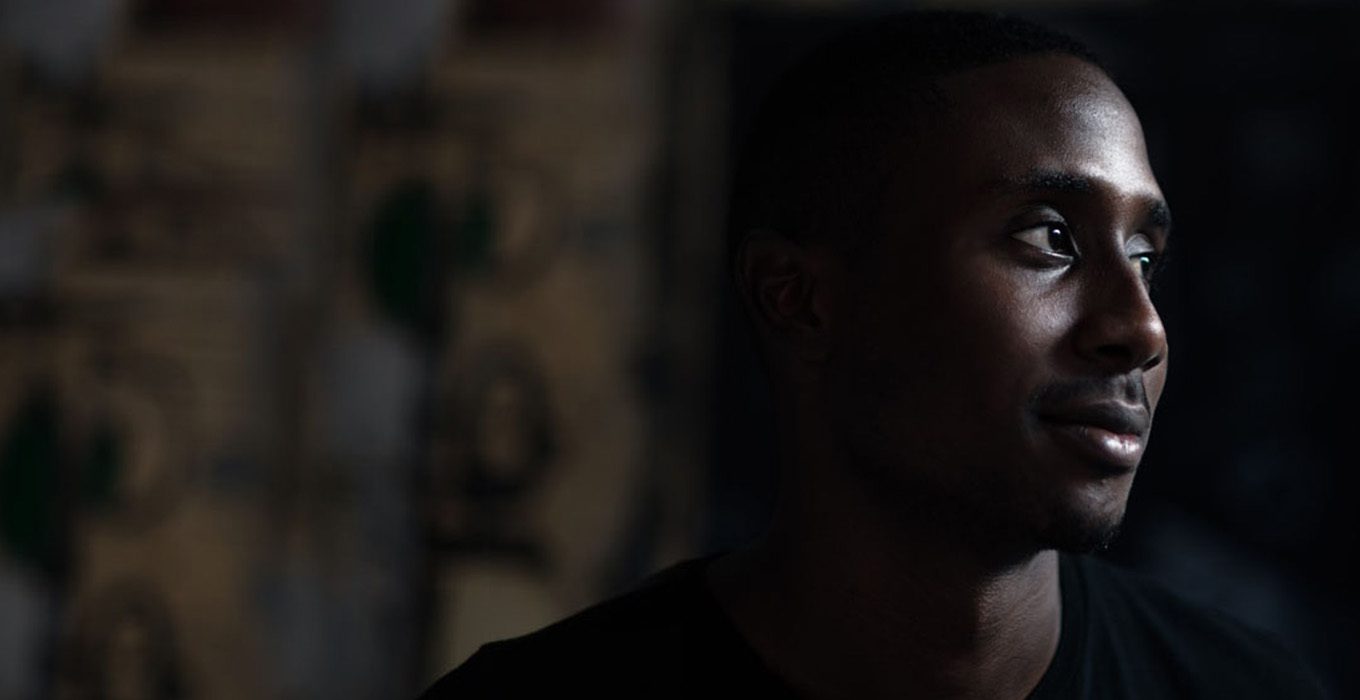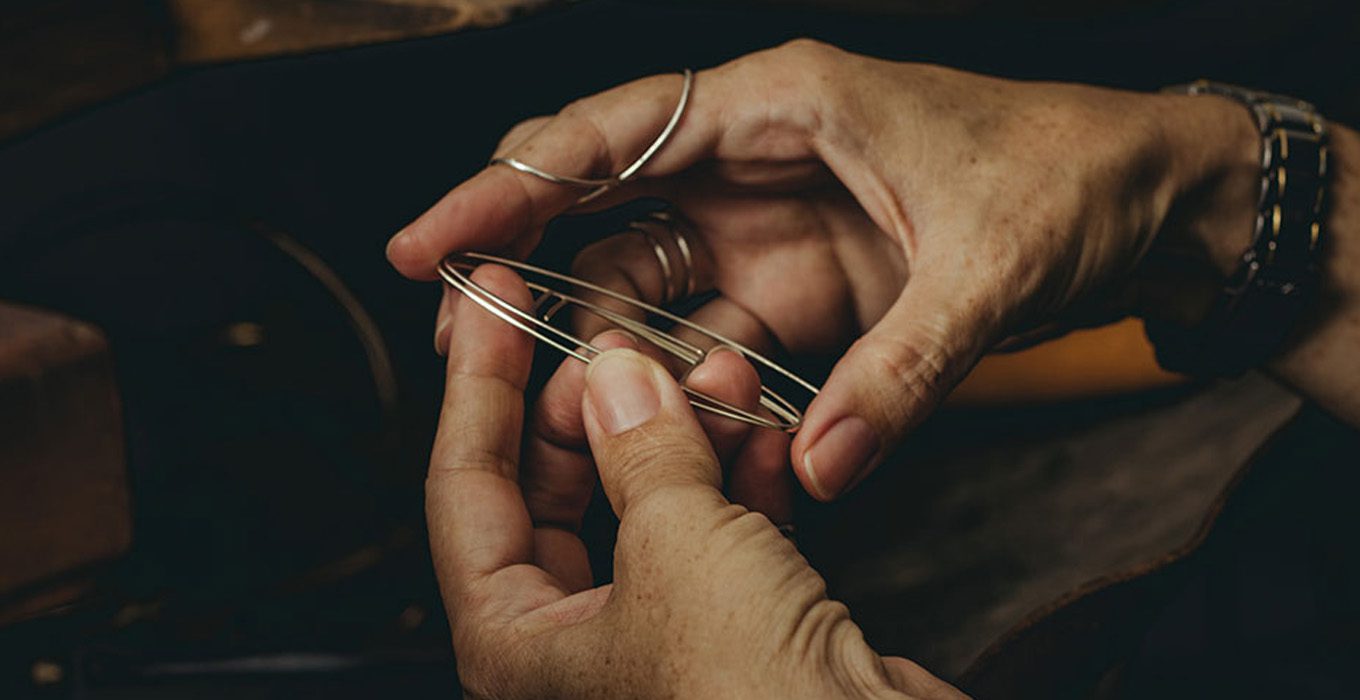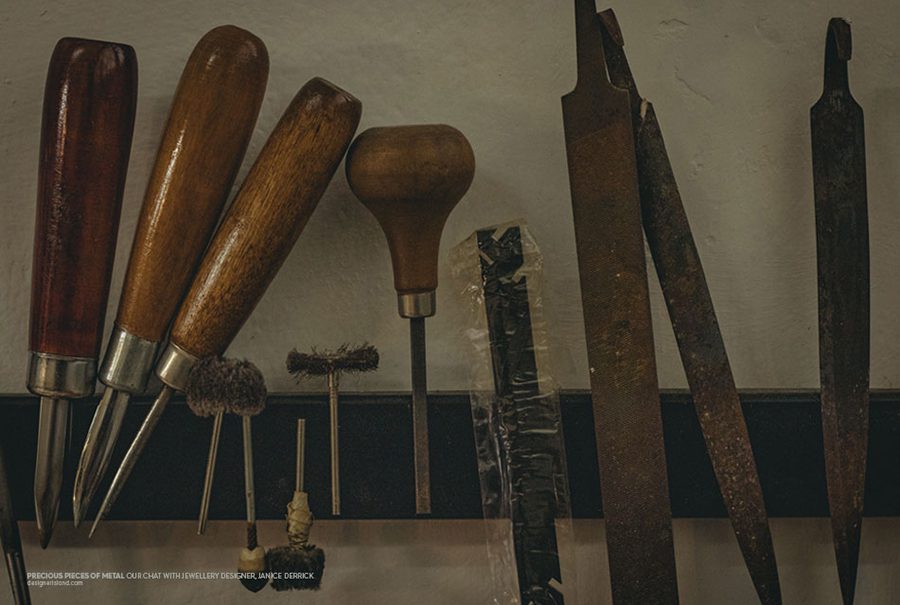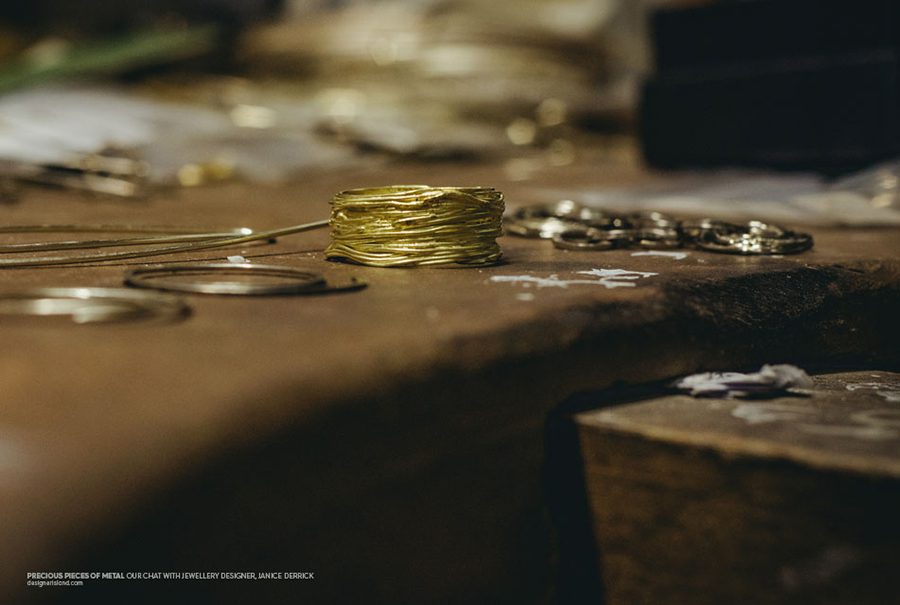

November 20, 2019
What is success? What does it look like? What does it feel like for designers and creatives living and working on an island in the sun?
For Janice Derrick, it’s defined by a lifelong career dedicated to transforming metal into jewellery that you’ll want to wear forever.
As a Caribbean designer of contemporary jewellery, Janice’s beautifully made pieces are inspired by architecture and geometry. Her shapes and lines have been quietly refined over years of rigorous, focused discipline and attention to detail.
I’ve always been a great admirer of Janice’s work and she was one of the first designers on our ultimate Christmas wish list. When we sat with Janice at her home studio in St. Ann’s, I couldn’t help but ask about the impact her work life has on her family life, as the mother of two boys, since I’m currently attempting to the navigate the so-called work/life balancing act with my two young sons.
She shared with us her process, the story of her transition from an artist who once sold her pieces to Barney’s in New York to the artist she is now, her successes and her influences. Enjoy.
Tell me about your childhood, growing up. What was home-life like?
JANICE: I was born and grew up in Cascade, in a sleepy, dead-end private road at the top of Knightsbridge. Behind our house, over the hill, was the Lady Young Road. All the kids on our street would walk up the track behind the houses to the Lady Young and we spent a lot of time riding and playing in the road together.
I’m an only child but there were two sisters who lived two houses away that I pretty much grew up with, they were like my sisters and are now my children’s godparents.
My parents had a difficult marriage and tried to get a divorce when I was about 13 or 14, but it was very traumatic. Every day during that time, I was going to school in tears so, in the end, they stopped… they’re still legally married but separated. The funny thing is they get along so much better now, 30 odd years later.
“At 16, I just wanted to get out of England, get back to Trinidad and get back to my friends. It was a difficult age.”
At some point, you migrated to England, right?
JANICE: Yes. I left Trinidad with my mum when I was 16 years old but it wasn’t what I wanted. My childhood memories of holidays spent in England were of being dragged around to very boring, very old, cold castles by my mum and granny. Being an only child, it was just me and these two ‘old’ folks, so it wasn’t a lot of fun.
If you think about it, at 16, your friends and your social life are everything… I used to dance and when I got to England, I didn’t know anybody and I didn’t have dance or anything else to turn to.
So you continued school there?
JANICE: Yes, when we first arrived in the UK we visited a few schools, including The Misbourne, which seemed to be more relaxed than the other schools we had seen so I really thought I could fit in there. I started in the January and, even though I made some really good friends, I dropped out by Easter because I just didn’t like it, more I think because I was so homesick.
After that, I went to work in the reclaim department of an aluminum factory. I had the job of checking boxes of foil trays to make sure there were no defects. I did that for maybe a month but, by then, I’d saved up enough spending money to come back to Trinidad to see my friends. That’s all I wanted to do. At 16, I just wanted to get out of England, get back to Trinidad and get back to my friends. It was a difficult age.
Returning must have been tough. What did you do when you got back?
JANICE: When I returned to the UK, my mom had moved us from London to the Midlands, so I went to Sutton College to do my A’Levels in Art, Biology and Geography. I then went on to do my Art Foundation Course and that’s when I really started to enjoy myself!
In the 3-D department, I started working in wood, plaster of Paris and papier-mâché. There were quite a few big table saws and jigsaws in the workshops and I remember seeing a guy cut the end of his finger off… it was just that kind of environment and I loved it!
Soon, I realised that one of our tutors, Marcus Steele, was a jeweller by trade, even though they didn’t actually teach jewellery at the college. As part of the course he took our group on an outing to the British museum where, after seeing their jewellery exhibition, I realised where my interests really lay, so I spoke with Marcus and arranged to meet him one lunchtime so he could introduce me to metal.
There was a backroom at college with a forge and bins of old scrap metal where you could work in metal.
The first time we met, he took a piece of rough iron and started hammering it and shaping it like an Italian mask. He soldered a long nose onto it and kept hammering away, and I was like, “Oh my God! Look at this thing… it’s transformed!”
So I started incorporating more and more metal into my work until I realised that I wanted to go to university to do silversmithing. But there were so many options! There was Central St Martin’s, which was known as one of the best art colleges. There were also the traditional jewellery courses but I finally chose the Silversmithing, Jewellery and Allied Crafts course at London Guildhall University (now the London Metropolitan University). In this course we were exposed to a variety of materials and learned how to create large-scale pieces, as well as traditional jewellery pieces.
By the end of the four-year course, I had my own workshop set up at home. I would come in for meetings with my tutor Simone ten Hompel right up until I completed and delivered my final presentation, which was a collection of ten sculptural rings. They weren’t very practical, but they were closely based on my collection of drawings and were surprisingly comfortable to wear.
As a side note, I wrote my final dissertation on Peter Minshall. It was very well received and I was awarded a First for it.
So what was next?
JANICE: I had two working placements during my time at university. The first one was at the Royal Shakespeare Company; while I’ve always been interested in jewellery, I wanted to learn more about adornment as well. So I worked in The Pit Theatre at the Barbican Centre as Assistant Wardrobe Mistress and Assistant Costume Supervisor where I had to source costumes and make sure the wardrobes were ready for the actors before each performance. It wasn’t directly linked to my degree but it was an amazing experience.
After that, I came to Trinidad and worked with Gillian Bishop and Darrell Nathaniel in The Signature Collection’s workshops, which was another great experience. I was also lucky enough to work alongside Pat Bishop and had the chance to include my own small collection in the exhibition I helped her set up at Gallery 1234 at the Normandie for Christmas 1994, titled ‘She Walks in Beauty’.
“I think what I needed – which I realised after a short time – was to simplify. So it became more about shapes and clean lines and movement, which is what I think is still the foundation of my work today.”
Looking back, what would you say your process was?
JANICE: Recently, I found crates and crates of magazine pages. Back then, I used to sit for hours pulling images out of magazines. Some of them made it to the pages of my sketchbooks and I used to experiment with combinations of images, materials, drawing and collage. And, in my final year, something interesting started happening: the sketches and designs seemed to be transforming and became more playful… I started to create models of little creatures out of metal and wire. I kept going in this new, slightly different direction, back and forth, until it turned into jewellery.
At university, we had class critiques on a regular basis, which taught us to honestly assess ourselves and I think what I needed – which I realised after a short time – was to simplify. So it became more about shapes and clean lines and movement, which is what I think is still the foundation of my work today.
These days though, thoughts and ideas for pieces mull around in my mind, sometimes for months before a pen touches paper or heat touches metal. In that realm they grow and transform and are refined quietly.
“I made a lot of rings early on because I love to look at people’s hands. People are very expressive with their hands and, to me, what’s worn on your fingers says a lot about who you are.”
When I look at your work, I see a lot of rings.
JANICE: Yes, rings made up my first works, definitely. I made a lot of rings early on because I love to look at people’s hands. People are very expressive with their hands and, to me, what’s worn on your fingers says a lot about who you are.
Quite often for me, a new collection would start with the rings. I’d work on the designs and incorporate other pieces but rings are definitely my thing. It’s interesting, earrings are what I dislike to make the most but I sell more earrings than anything else.
Obviously, your own likes and dislikes come through your designs into your jewellery and I’ve never liked heavy jewellery so my jewellery is light. I think that’s what people like about my work — it’s light and easy to wear so you don’t feel weighed down by the piece.
I think how things are designed is something I’ve always considered: the wearability, the practicality, the comfort.
Pieces that people will want to wear forever, pieces that are precious yet comfortable. Pieces that people will want to pass on to the next generation and that they in turn will also wish to wear them.
From a more practical side, how did you get the business started?
JANICE: I applied for a grant and I got it!
In London, there was a grant called the Clerkenwell Award, which was awarded once a year. I applied for it with a jeweller that I studied with at university. We didn’t want to set up on our own as we were still young and had a lot to learn. So we applied together as two separate businesses that would share one studio and we got through, a few months after we graduated.
We set up our studio and had business advisors that met with us every week to see how we were progressing, to review our business plans and to help us figure out a lot of start-up issues. It was great but I still don’t think I was prepared for the 20 rejection letters I received in the first year!
I was slowly able to build up a collection of galleries that were showing my work and then I applied for the Chelsea Craft Fair, which was the most prestigious craft fair in Europe at the time. It was tough but worth it because it prepared me for meeting gallery owners and buyers, selling to the public and exhibiting with other designers through the British Craft Council.
Through the Craft Council, I got to go to Munich and San Francisco and New York for trade fairs and ended up meeting the buyers from The Store at the Museum of Arts and Design and they carried my work for years.
It took me a long time to realise that, as prestigious as it sounded, it involved so much extra work: it was overwhelming and eventually I decided I’d rather concentrate on a local audience and a simpler life at least for now.
I had learned a similar lesson when Barney’s in New York wanted to carry my work but they wanted 50 pieces of an item. I remember saying, “How do you do that?” because I hand-make everything. I filled the orders but it didn’t take long for me to realise that ‘churning’ out work was not for me.
It felt like I no longer loved making jewellery because I didn’t have the time or the energy to come up with new creations, especially when what I wanted to do was special one-off pieces and limited editions. I never wanted everyone to have the same thing… even more so here in Trinidad! Ideally, I don’t want my clients to walk into an event and someone else has on the same earrings.
So you’re here now, doing this year round?
JANICE: Pretty much, but I really only work part-time at the moment as my children are still fairly young. There are times in the year when I work more intensely and I’ve been looking for a skilled assistant for a few years, which would be a great help but so far I haven’t had any luck.
Even as a graphic designer, I aspire to your level when it comes to a beautiful finish. That’s something I’ve always admired about your work…
JANICE: Thank you! And that, I think, is the difference! I see a lot of younger jewellers, especially if they’ve not had formal training, who don’t see that detail. So they make a piece and are like, “Yeah, that’s it.”
So what led you to leave England and come back to Trinidad?
JANICE: I think I always knew that being in London was a temporary situation. I was there for 17 years but eventually the weather and the darkness got to me.
I never got used to that… apart from the brief summers I was always cold. And I hated arriving at school or work in the dark and then leaving in the dark.
I wanted more light, and here had light.
My return happened organically though… at the time I was teaching and my mum’s birthday was coming up at the same time as my half-term holiday. She said to me, “How about if we go to Trinidad for the week?” It was such a lovely surprise, so we came and within days I fell in love with a house that was for sale in the neighbourhood I grew up in. It wasn’t long before the decision to move back permanently was made. That was about 15 years ago.
And how was that transition?
JANICE: At the time, I sold my work in Europe, the UK, the States and Japan. I had to get in touch with everyone to tell them I was returning to the Caribbean and to find out if they’d still be interested in working with me.
A lot of people said no, unfortunately but understandably. I saw it coming and knew that this was going to be a very big change in my life.
On one of my visits to Trinidad before moving back, I met with my friend Mariel Brown, and fellow jewellers Barbie Jardine, Rachel Ross and Jasmine Thomas-Girvan, to get an idea of what the environment was like: we discussed if the move made sense and if jewellery would work or if I should be changing my career as I was determined to come home. They were all like, “Yes! Of course! Come home and make jewellery!”
They were incredibly giving and loving and through that we came up with the idea of Flux and Fire: Five Jewellers and their Art, the exhibition that was held at the National Museum in September 2005.
The five of us were thinking how great it would be if we could host an exhibition featuring Caribbean contemporary jewellery. There had been many exhibitions and studies on Caribbean art, sculpture and fashion, but never on jewellery.
“They don’t take their professionalism further. They don’t go as far as they should, even though the potential is there. And that’s not good enough because we should be able to stand on par with anybody else in the world.”
Listening to you, this is really a story of finding yourself but also starting over…
JANICE: In England I had been in an environment where it was possible to find myself and become who I wanted to become. The daunting part was coming back here. I could’ve fallen flat on my face and all the hard work I had put in over the previous eight years would have been wasted. Thankfully, it wasn’t!
One of my biggest concerns about coming back to Trinidad was that I wouldn’t be stimulated enough to maintain the standard of my work because there’s always the fear that because I’m here on this little island, my work isn’t as good… You know that feeling? But it seems that the outside world still recognises me. On social media, they’ll comment positively on a piece I’ve posted, and that’s a good feeling. It means that I haven’t let myself down.
But you know what? There are a large number of creative people in Trinidad in all different spheres. It’s incredible. If I describe this to creative people abroad, they just can’t believe how this tiny island has so much creativity.
I remember having this conversation with Meiling years ago: being creative is one thing but some people here feel like they don’t need to push themselves, that mediocre is okay. So, they produce their creation and it’s good but they often don’t push to the next level. They don’t take their professionalism further. They don’t go as far as they should, even though the potential is there. And that’s not good enough because we should be able to stand on par with anybody else in the world.
As long as my work can compete with work from international designers, that means that I am doing what I’m supposed to be doing. I know people have copied my designs and are selling them for less than I do, the materials and finish are not comparable, but people here are sometimes lazy in their choices. And even though I date all my designs, I have no recourse here for my copyright. The local copyright organisations only treat with music and maybe literature, but not design so we have nothing to work with.
As I see it, I just need to keep one step ahead, keep doing new and better. It’s not easy but there’s really no alternative.
I think I have my last question and I don’t know how you’ll choose to answer this. Having made such a difficult decision to move here at the risk of losing international clients, what does success look like or feel like to you?
JANICE: I think that’s changed a lot over the years. Right now, it’s definitely more of a personal thing rather than an outward thing. If I can wake up in the morning feeling happy and at peace, that’s success.
If I can afford to go on a few holidays – even one holiday a year – and my boys have the things they need and I can maintain my home, which is always falling apart, (Laughter) that, to me, is success.
If my clients continue to admire and seek out my work and I have the respect of my colleagues and fellow jewellers, that’s success…
That’s what I love and actually appreciate more because they know the struggle that we go through to do this. So I think the respect of other makers is success.
“And finally, just to be grateful and content with life, to be healthy, to feel that you’re in a good place; that’s success!”
SEE JANICE DERRICK’S WORK AT: JANICEDERRICK.COM


Interviewer: TANYA MARIE. photographer + videographer: CLAYTON RHULE